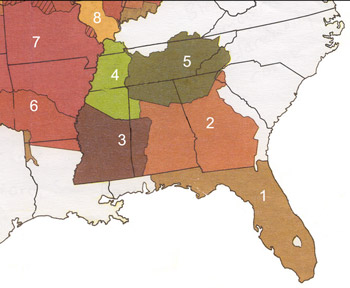|

indian
Removal Policy
"The evil, Sir, is enormous; the inevitable suffering
incalculable. Do not stain the fair fame of the country.
. . . Nations of dependent Indians, against their will,
under color of law, are driven from their homes into the
wilderness.
You cannot explain it; you cannot reason it away. . .
. Our friends will view this measure with sorrow, and our
enemies
alone with joy. And we ourselves, Sir, when the interests
and passions of the day are past, shall look back upon
it, I fear, with self-reproach, and a regret as bitter
as unavailing."
Edward Everett, "Speeches on the Passage
of the Bill for the Removal of the Indians
Delivered in
the Congress
of the
United States" (Boston, 1830) in
Native American
Voices: A History and Anthology, ed. Steven Mintz
(St.
James, New York: Brandywine P, 1995), 114.
 |
Key:
1. Seminole
2. Creek
3. Choctaw
4. Chickasaw
5. Cherokee
6. Quapaw
7. Osage
8. Illinois Confederation |
| Adapted from Sam Bowers
Hilliard, "Indian
Land Cessions" [detail], Map Supplement 16, Annals
of the Association of American Geographers, vol.
62, no. 2 [June 1972]. From National Park Service |
In
1830, the United States government adopted removal as its
official policy.
Read
the text of the Indian Removal
Act of 1830
The
removal policy precipitated an acrimonious debate in the Senate.
President
Andrew Jackson defended Indian in his First, Second, and Seventh
Annual Addresses.
Chief John Ross and other leaders of the Cherokee nation
wrote a letter to Congress to protest the 1835 Treaty of
New
Echota. This treaty, signed by a group of Cherokees claiming
to represent their people, stated that the tribe would relocate
west of the Mississippi. The majority of Cherokees, over
15,000,
opposed the treaty.
- Read
Ross' letter (1836)
In
this letter, Chief Ross and the others state the case
for the Cherokee majority.
These political cartoons portray opinions about Indian removal
policy and effects:
|
